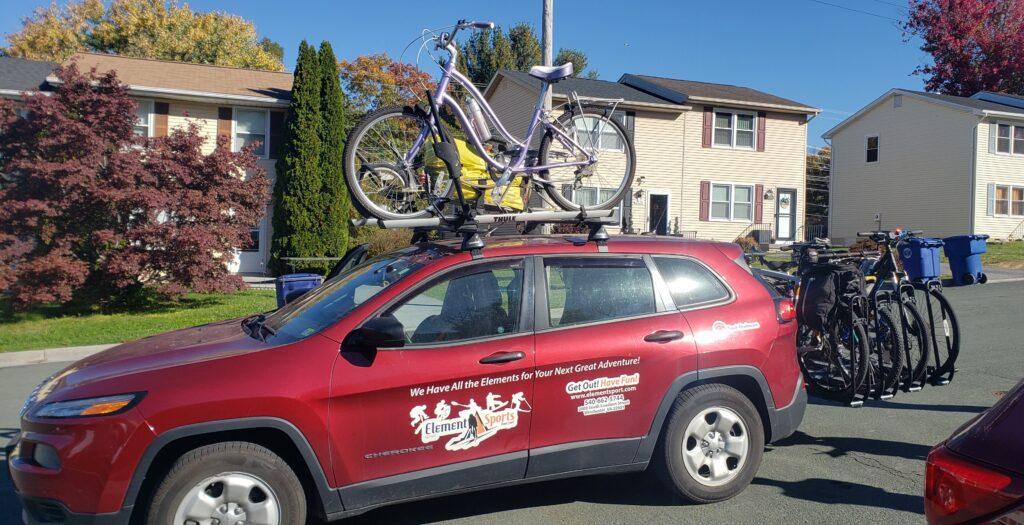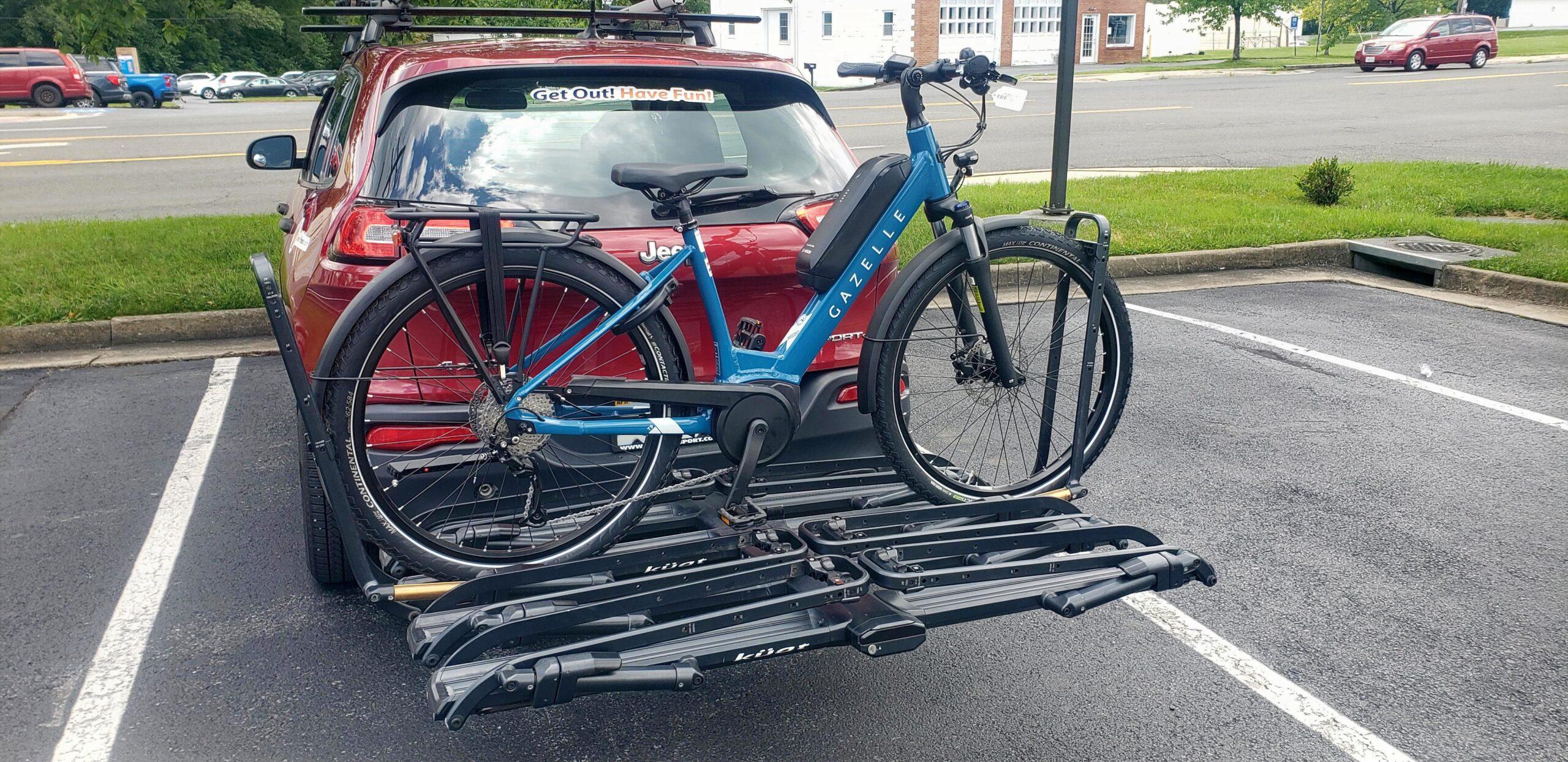You’ve come in to the shop, spent some time finding the perfect bike, been shown all the ins and outs of the bike and accessories you need to ride. You get ready to head out the door when you realize that you need some way to take the bike home. What is the best way to transport your bike home, and then from place to place?
Well, the answer will vary depending on your vehicle, your needs, your size and strength, and what bike you are hauling. In general, there are about 6 ways to take a bike on a vehicle. We’ll go over the various methods and the pros and cons of each so you can have an idea of what might work best for you.
1. Inside the vehicle. A lot of people choose to stuff the bike inside their vehicle. With a large vehicles like a mini-van, it can be quite simple to stash it inside. With a small vehicle like a coupe, wheels and other parts may need to be removed to make it fit. The pros to this method of vehicular transport of a bicycle are several. It’s cheap, since you don’t need to buy anything else to transport the bike. It’s safe, in that the bike is protected from theft or accident, at least in comparison to other methods. The cons are that it takes up potentially needed space inside the vehicle for people or other items. It also may take extra time and effort disassembling and reassembling the bike. And finally, the bike can potentially be damaged by how it’s put in the car or by other things in the car.
2. In the bed of a pickup truck. This is another popular method for carrying bikes. Again, it can be cheap, as nothing more necessarily needs to be purchased (though there are options that make it even easier and organize the bikes while in the bed). Pros to using a truck bed rack is that some have locks to secure the bikes, the bikes are generally out of harm’s way, and it is convenient. Cons are that you may have to lift the bike somewhat high depending on the height of the bed, and you loose space to carry other stuff in the bed while carrying bikes.
3. Trunk racks. Trunk racks are useful for cars like sedans or hatchbacks, or on minivans or SUVS. Trunk racks have many great features: convenient, don’t generally require lifting the bikes very high, are not very expensive, and can carry multiple bikes. Some even have locks to secure the bikes to the rack and to the vehicle. The cons are that not every vehicle can take a trunk rack. Some vehicles have plastic rear window spoilers that cannot take the weight of a rack. Trunk racks also are sometimes difficult to use to their full capacity – we generally recommend buying a rack that carries one more bike than you plan to carry – so buy a 3 bike rack if you only plan to carry 2. Just makes it easier to use. And with women’s bikes, you may need to use an extra adapter to get the bike to fit. And finally, most trunk racks are not rated to carry e-bikes.

4. Roof racks. Roof racks are great for carrying bikes for a variety of reasons. They carry the bikes securely and safely. They generally lock so your bike cannot be stolen. They free up space within the vehicle for other cargo or people. And roof racks look really good. But, they have drawbacks. If you are shorter in stature, putting the bike on top may prove difficult. Or if your bike is heavy. Carrying e-bikes on the roof is too much for most people. Personally, I only use the roof rack once I’ve already filled up hitch rack I have on the rear of my vehicle. One other drawback to roof racks is that you must be careful to avoid hitting low hanging objects, like drive-thrus at restaurants and banks. Lastly, roof racks are somewhat expensive, especially if you do not already have a roof rack, as you’ll need to install that first before adding bike trays.
5. Hitch Racks. I will not be shy in stating that hitch racks are my preferred method for hauling bikes. They hold the bikes securely and allow you space inside your vehicle to carry people and cargo. They tend to be very easy to use. Most enable the bikes to be locked to the rack and vehicle. There are some drawbacks: lower priced models hang bikes like trunk racks, so are sometimes difficult to put as many on as it is rated to carry, and you may need adapters for step-thru bikes. Platform racks avoid these problems, but tend to cost more. However, if you are hauling an e-bike, a platform hitch rack is often your only option. One other con to hitch racks is the same as trunk racks: the bikes are vulnerable to damage by an inattentive driver rear ending you. And lastly, if your car does not have a hitch, there is the expense of having one installed before purchasing the bike rack (see Trick Trucks in Kernstown to get a hitch installed). But overall, the ease of use of a hitch rack make them my preferred method of hauling bikes. Mine carries 4 and even has lights built in. You can even get models that hold 6 or more bikes.
6. In/on a Trailer. Lastly, you could attach a trailer to the back of your vehicle and put the bikes in or on it. Some trailers would allow you to put the bikes inside, others like one I have has roof rack bike trays to carry bikes. The pros to a trailer is the ability to haul more and keep stuff out of your actual vehicle, as well as keep the bikes generally safe and away from thieves. But they are, of course, more costly. And they are not always so easy to use or navigate in tight spaces.
If you have any questions about which method of hauling a bike with your vehicle is best for you, stop in and chat with us. We’ll be happy to help!



Comments are closed